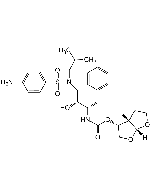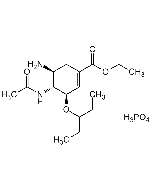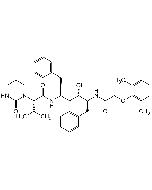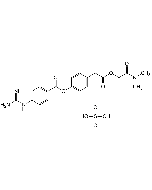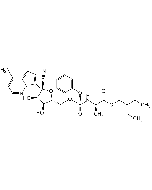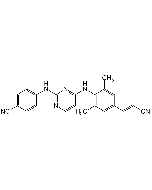Cookie Policy: This site uses cookies to improve your experience. You can find out more about our use of cookies in our Privacy Policy. By continuing to browse this site you agree to our use of cookies.
AdipoGen Life Sciences
Efavirenz
As low as
50
CHF
CHF 50.00
In stock
Only %1 left
AG-CR1-3751-M01010 mgCHF 50.00
AG-CR1-3751-M05050 mgCHF 140.00
AG-CR1-3751-M250250 mgCHF 320.00
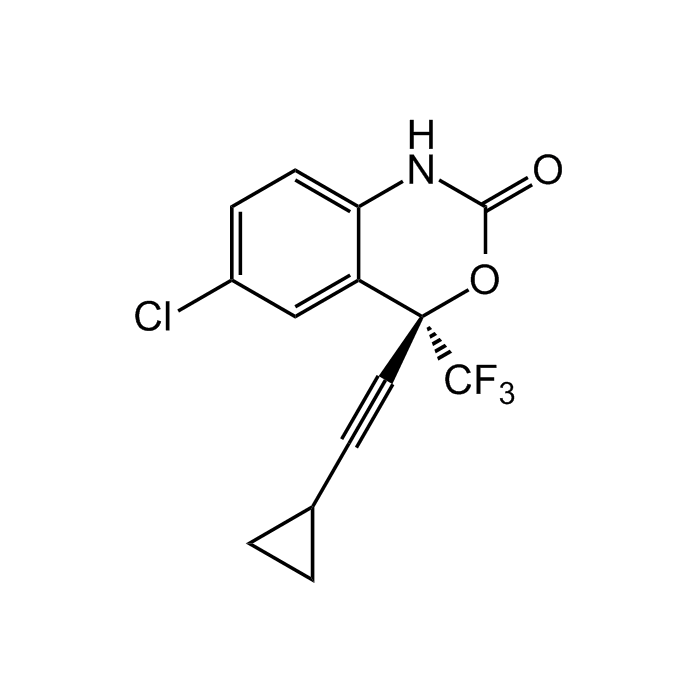
| Product Details | |
|---|---|
| Synonyms | DMP 266; EFV; L-743,726 |
| Product Type | Chemical |
| Properties | |
| Formula |
C14H9ClF3NO2 |
| MW | 315.7 |
| CAS | 154598-52-4 |
| RTECS | DM3440000 |
| Purity Chemicals | ≥98% (HPLC) |
| Appearance | White to off-white solid. |
| Solubility | Soluble in DMSO (25mg/ml), DMF (20mg/ml) or ethanol (10mg/ml). Insoluble in water. |
| Identity | Determined by 1H-NMR. |
| InChi Key | XPOQHMRABVBWPR-UHFFFAOYSA-N |
| Smiles | ClC1=CC=C2C([C@@](C#CC3CC3)(C(F)(F)F)OC(N2)=O)=C1 |
| Shipping and Handling | |
| Shipping | AMBIENT |
| Short Term Storage | +4°C |
| Long Term Storage | -20°C |
| Handling Advice | Keep cool and dry. |
| Use/Stability | Stable for at least 2 years after receipt when stored at -20°C. |
| Documents | |
| MSDS |
 Download PDF Download PDF |
| Product Specification Sheet | |
| Datasheet |
 Download PDF Download PDF |
Description
- Efavirenz is a non-nucleoside reverse transcriptase inhibitor (NNRTI) that exhibits antiviral and anticancer activities.
- Efavirenz binds to wild-type and mutant HIV-1 RTs (Ki= 2.93nM and 3.85-56.5nM, respectively). It inhibits wild-type and mutant HIV-1 viral replication in MT-4 human T lymphoid cells (IC95s = 1.5-1,500 nM). Efavirenz also prevents RNA plus-strand initiation with an IC50 value of 17nM.
- Efavirenz is an anti-HIV drug, commonly used in combination therapy for AIDS treatment. It is part of highly active antiretroviral therapy (HAART) for the treatment of a human immunodeficiency virus (HIV) type 1.
- In various cancer cell lines, Efavirenz inhibits cellular proliferation and increases activation of p53.
- CARD8 inflammasome senses HIV-1 protease activity. In HIV-infected cells, CARD8 cannot detect the virus because the viral protease remains inactive as a subunit of unprocessed Gag-Pol polyprotein. HIV-1-specific non-nucleoside reverse transcriptase inhibitors (NNRTIs), such us Efavirenz, can trigger CARD8 sensing because they bind to HIV-1 Pol and enhance intracellular Gag-Pol polyprotein dimerization, which causes premature viral protease activation. Treating HIV-1-infected macrophages and CD4+ T cells with NNRTIs leads to CARD8-mediated caspase-1 activation and pyroptotic cell death. Induction of the CARD8 inflammasome activation has led to rapid clearance of latent HIV-1 in patient CD4+ T cells after virus reactivation.
Product References
- L-743,726 (DMP-266): A novel, highly potent nonnucleoside inhibitor of the human immunodeficiency virus type 1 reverse transcriptase: S.D. Young, et al.; Antimicrob. Agents Chemother. 39, 2602 (1995)
- The nonnucleoside reverse transcriptase inhibitors efavirenz and nevirapine in the treatment of HIV: M. Sheran; HIV Clin. Trials 6, 158 (2005)
- HIV-susceptible transgenic rats allow rapid preclinical testing of antiviral compounds targeting virus entry or reverse transcription: C. Goffinet, et al.; PNAS 104, 1015 (2007)
- HIV-1 reverse transcriptase plus-strand initiation exhibits preferential sensitivity to non-nucleoside reverse transcriptase inhibitors in vitro: J.A. Grobler, et al.; J. Biol. Chem. 282, 8005 (2007)
- Efavirenz in the therapy of HIV infection: N.Y. Rakhmanina & J.N. van den Anker; Expert Opin. Drug Metab. Toxicol. 6, 95 (2010)
- Cytotoxic effect of efavirenz is selective against cancer cells and associated with the cannabinoid system: M. Hecht, et al.; AIDS 27, 2031 (2013)
- Efavirenz induces neuronal autophagy and mitochondrial alterations: P.R. Purnell & H.S. Fox; J. Pharmacol. Exp. Ther. 351, 250 (2014)
- Mechanism of allosteric inhibition of HIV-1 reverse transcriptase revealed by single-molecule and ensemble fluorescence: G.D. Schauer, et al.; Nucleic Acids Res. 42, 11687 (2015)
- CARD8 is an inflammasome sensor for HIV-1 protease activity: Q. Wang, et al.; Science 371, 6535 (2021)








